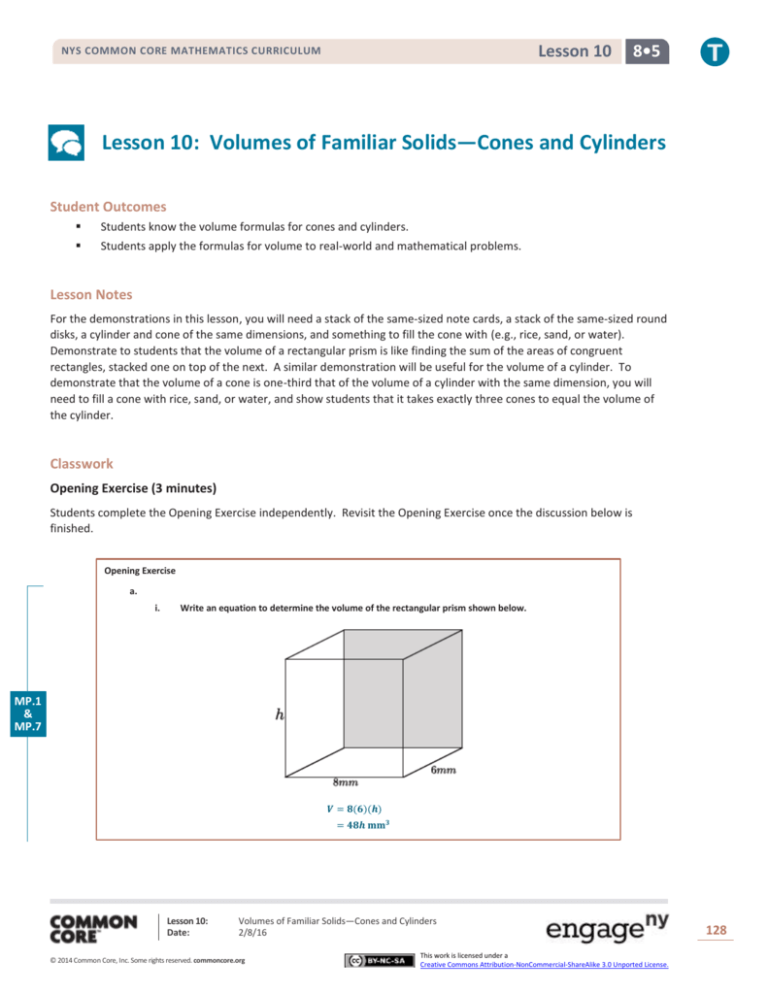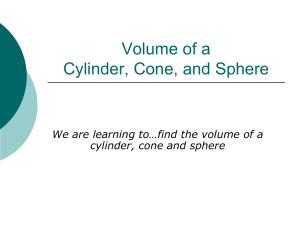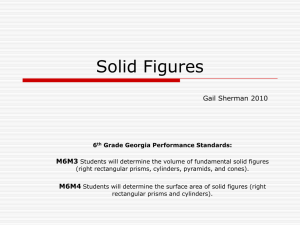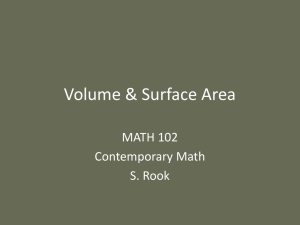
Lesson 10
NYS COMMON CORE MATHEMATICS CURRICULUM
8•5
Lesson 10: Volumes of Familiar Solids―Cones and Cylinders
Student Outcomes
Students know the volume formulas for cones and cylinders.
Students apply the formulas for volume to real-world and mathematical problems.
Lesson Notes
For the demonstrations in this lesson, you will need a stack of the same-sized note cards, a stack of the same-sized round
disks, a cylinder and cone of the same dimensions, and something to fill the cone with (e.g., rice, sand, or water).
Demonstrate to students that the volume of a rectangular prism is like finding the sum of the areas of congruent
rectangles, stacked one on top of the next. A similar demonstration will be useful for the volume of a cylinder. To
demonstrate that the volume of a cone is one-third that of the volume of a cylinder with the same dimension, you will
need to fill a cone with rice, sand, or water, and show students that it takes exactly three cones to equal the volume of
the cylinder.
Classwork
Opening Exercise (3 minutes)
Students complete the Opening Exercise independently. Revisit the Opening Exercise once the discussion below is
finished.
Opening Exercise
a.
i.
Write an equation to determine the volume of the rectangular prism shown below.
MP.1
&
MP.7
𝑽 = 𝟖(𝟔)(𝒉)
= 𝟒𝟖𝒉 𝐦𝐦𝟑
Lesson 10:
Date:
Volumes of Familiar Solids—Cones and Cylinders
2/8/16
© 2014 Common Core, Inc. Some rights reserved. commoncore.org
This work is licensed under a
Creative Commons Attribution-NonCommercial-ShareAlike 3.0 Unported License.
128
Lesson 10
NYS COMMON CORE MATHEMATICS CURRICULUM
ii.
8•5
Write an equation to determine the volume of the rectangular prism shown below.
𝑽 = 𝟏𝟎(𝟖)(𝒉)
= 𝟖𝟎𝒉 𝐢𝐧𝟑
MP.1
&
MP.7
iii.
Write an equation to determine the volume of the rectangular prism shown below.
𝑽 = 𝟔(𝟒)(𝒉)
= 𝟐𝟒𝒉 𝐜𝐦𝟑
iv.
Write an equation for volume, 𝑽, in terms of the area of the base, 𝑩.
𝑽 = 𝑩𝒉
Lesson 10:
Date:
Volumes of Familiar Solids—Cones and Cylinders
2/8/16
© 2014 Common Core, Inc. Some rights reserved. commoncore.org
This work is licensed under a
Creative Commons Attribution-NonCommercial-ShareAlike 3.0 Unported License.
129
Lesson 10
NYS COMMON CORE MATHEMATICS CURRICULUM
b.
8•5
Using what you learned in part (a), write an equation to determine the volume of the cylinder shown below.
𝑽 = 𝑩𝒉
= 𝟒𝟐 𝝅𝒉
= 𝟏𝟔𝝅𝒉 𝐜𝐦𝟑
MP.1
&
MP.7
Students do not know the formula to determine the volume of a cylinder, so some may not be able to respond to this
exercise until after the discussion below. This is an exercise for students to make sense of problems and persevere in
solving them.
Discussion (10 minutes)
We will continue with an intuitive discussion of volume. The volume formula from the last lesson says that if
the dimensions of a rectangular prism are 𝑙, 𝑤, ℎ, then the volume of the rectangular prism is 𝑉 = 𝑙 ∙ 𝑤 ∙ ℎ.
Scaffolding:
Demonstrate the volume of a
rectangular prism using a stack
of note cards. The volume of
the rectangular prism increases
as the height of the stack
increases. Note that the
rectangles (note cards) are
congruent.
Referring to the picture, we call the blue rectangle at the bottom of the rectangular prism the base, and the
length of any one of the edges perpendicular to the base the height of the rectangular prism. Then, the
formula says
𝑉 = (area of base) ∙ height.
Lesson 10:
Date:
Volumes of Familiar Solids—Cones and Cylinders
2/8/16
© 2014 Common Core, Inc. Some rights reserved. commoncore.org
This work is licensed under a
Creative Commons Attribution-NonCommercial-ShareAlike 3.0 Unported License.
130
Lesson 10
NYS COMMON CORE MATHEMATICS CURRICULUM
8•5
Examine the volume of a cylinder with base 𝐵 and height ℎ. Is the solid (i.e., the totality of all the line
segments) of length ℎ lying above the plane so that each segment is perpendicular to the plane, and is its
lower endpoint lying on the base 𝐵 (as shown)?
Scaffolding:
Do you know a name for the shape of the base?
No, it is some curvy shape.
Let’s examine another cylinder.
Do we know the name of the shape of the base?
The line segments appear to be perpendicular to the base.
What angle does the line segment appear to make with the base?
It appears to be a circle.
What do you notice about the line segments intersecting the base?
Clearly stating the meanings of
symbols may present
challenges for English language
learners, and as such, students
may benefit from a menu of
phrases to support their
statements. They will require
detailed instruction and
support in learning the nonnegotiable vocabulary terms
and phrases.
The angle appears to be a right angle.
When the base of a diagram is the shape of a circle and the line segments on the base are perpendicular to the
base, then the shape of the diagram is called a right circular cylinder.
We want to use the general formula for volume of a prism to apply to this shape of a right
circular cylinder.
What is the general formula for finding the volume of a prism?
MP.8
What is the area for the base of the right circular cylinder?
The area of a circle is 𝐴 = 𝜋𝑟 2 .
What information do we need to find the area of a circle?
𝑉 = (area of base) ∙ height
Scaffolding:
Demonstrate the volume of a
cylinder using a stack of round
disks. The volume of the
cylinder increases as the height
of the stack increases, just like
the rectangular prism. Note
that the disks are congruent.
We need to know the radius of the circle.
What would be the volume of a right circular cylinder?
𝑉 = (𝜋𝑟 2 )ℎ
Lesson 10:
Date:
Volumes of Familiar Solids—Cones and Cylinders
2/8/16
© 2014 Common Core, Inc. Some rights reserved. commoncore.org
This work is licensed under a
Creative Commons Attribution-NonCommercial-ShareAlike 3.0 Unported License.
131
Lesson 10
NYS COMMON CORE MATHEMATICS CURRICULUM
MP.8
8•5
What information is needed to find the volume of a right circular cylinder?
We would need to know the radius of the base and the height of the cylinder.
Exercises 1–3 (8 minutes)
Students work independently or in pairs to complete Exercises 1–3.
Exercises 1–6
1.
Use the diagram at right to answer the questions.
a.
What is the area of the base?
The area of the base is (𝟒. 𝟓)(𝟖. 𝟐) = 𝟑𝟔. 𝟗 𝐢𝐧𝟐 .
b.
What is the height?
The height of the rectangular prism is 𝟏𝟏. 𝟕 𝐢𝐧.
c.
What is the volume of the rectangular prism?
The volume of the rectangular prism is 𝟒𝟑𝟏. 𝟕𝟑 𝐢𝐧𝟑 .
2.
Use the diagram at right to answer the questions.
a.
What is the area of the base?
𝑨 = 𝝅𝟐𝟐
𝑨 = 𝟒𝝅
The area of the base is 𝟒𝝅 𝐜𝐦𝟐.
b.
What is the height?
The height of the right circular cylinder is 𝟓. 𝟑 𝐜𝐦.
c.
What is the volume of the right circular cylinder?
𝑽 = (𝝅𝒓𝟐 )𝒉
𝑽 = (𝟒𝝅)𝟓. 𝟑
𝑽 = 𝟐𝟏. 𝟐𝝅
The volume of the right circular cylinder is 𝟐𝟏. 𝟐𝝅 𝐜𝐦𝟑 .
3.
Use the diagram at right to answer the questions.
a.
What is the area of the base?
𝑨 = 𝝅𝟔𝟐
𝑨 = 𝟑𝟔𝝅
The area of the base is 𝟑𝟔𝛑 𝐢𝐧𝟐.
b.
What is the height?
The height of the right circular cylinder is 𝟐𝟓 𝐢𝐧.
Lesson 10:
Date:
Volumes of Familiar Solids—Cones and Cylinders
2/8/16
© 2014 Common Core, Inc. Some rights reserved. commoncore.org
This work is licensed under a
Creative Commons Attribution-NonCommercial-ShareAlike 3.0 Unported License.
132
Lesson 10
NYS COMMON CORE MATHEMATICS CURRICULUM
c.
8•5
What is the volume of the right circular cylinder?
𝑽 = (𝟑𝟔𝝅)𝟐𝟓
𝑽 = 𝟗𝟎𝟎𝝅
The volume of the right circular cylinder is 𝟗𝟎𝟎𝝅 𝐢𝐧𝟑.
Discussion (10 minutes)
Next, we introduce the concept of a cone. We start with the general concept of a cylinder. Let 𝑃 be a point in
the plane that contains the top of a cylinder or height, ℎ. Then, the totality of all the segments joining 𝑃 𝑡o a
point on the base 𝐵 is a solid, called a cone, with base 𝐵 and height ℎ. The point 𝑃 is the top vertex of the
cone. Here are two examples of such cones.
Let’s examine the diagram on the right more closely. What is the shape of the base?
Where does the line segment from the vertex to the base appear to intersect the base?
It appears to be the shape of a circle.
It appears to intersect at the center of the circle.
What type of angle do the line segment and base appear to make?
It appears to be a right angle.
If the vertex of a circular cone happens to lie on the line perpendicular to the circular base at its center, then
the cone is called a right circular cone.
We want to develop a general formula for volume of right circular cones from our general formula for
cylinders.
If we were to fill a cone of height, ℎ, and radius, 𝑟, with rice (or sand or water), how many cones do you think it
would take to fill up a cylinder of the same height, ℎ, and radius, 𝑟?
Show students a cone filled with rice (or sand or water). Show students a cylinder of the same height and radius. Give
MP.3 students time to make a conjecture about how many cones it will take to fill the cylinder. Ask students to share their
guesses and their reasoning to justify their claims. Consider having the class vote on the correct answer before the
demonstration or showing the video. Demonstrate that it would take the volume of three cones to fill up the cylinder, or
show the following short, one-minute video http://youtu.be/0ZACAU4SGyM.
What would the general formula for the volume of a right cone be? Explain.
Provide students time to work in pairs to develop the formula for the volume of a cone.
Lesson 10:
Date:
Volumes of Familiar Solids—Cones and Cylinders
2/8/16
© 2014 Common Core, Inc. Some rights reserved. commoncore.org
This work is licensed under a
Creative Commons Attribution-NonCommercial-ShareAlike 3.0 Unported License.
133
Lesson 10
NYS COMMON CORE MATHEMATICS CURRICULUM
8•5
Since it took three cones to fill up a cylinder with the same dimensions, then the volume of the cone is
one-third that of the cylinder. We know the volume for a cylinder already, so the cone’s volume will be
1
3
of the volume of a cylinder with the same base and same height. Therefore, the formula will be
1
3
𝑉 = (𝜋𝑟 2 )ℎ.
Exercises 4–6 (5 minutes)
Students work independently or in pairs to complete Exercises 4–6 using the general formula for the volume of a cone.
Exercise 8 is a challenge problem.
4.
Use the diagram to find the volume of the right circular cone.
𝟏
(𝝅𝒓𝟐 )𝒉
𝟑
𝟏
𝑽 = (𝝅𝟒𝟐 )𝟗
𝟑
𝑽 = 𝟒𝟖𝝅
𝑽=
The volume of the right circular cone is 𝟒𝟖𝝅 𝐦𝐦𝟑.
5.
Use the diagram to find the volume of the right circular cone.
𝟏
(𝝅𝒓𝟐 )𝒉
𝟑
𝟏
𝑽 = (𝝅𝟐. 𝟑𝟐 )𝟏𝟓
𝟑
𝑽 = 𝟐𝟔. 𝟒𝟓𝝅
𝑽=
The volume of the right circular cone is 𝟐𝟔. 𝟒𝟓𝝅 𝐦𝐦𝟑.
6.
Challenge: A container in the shape of a right circular cone has height 𝒉, and base of radius 𝒓, as shown. It is filled
with water (in its upright position) to half the height. Assume that the surface of the water is parallel to the base of
the inverted cone. Use the diagram to answer the following questions:
a.
What do we know about the lengths of 𝑨𝑩 and 𝑨𝑶?
Then we know that |𝑨𝑩| = 𝒓, and |𝑨𝑶| = 𝒉.
b.
What do we know about the measure of ∠𝑶𝑨𝑩 and ∠𝑶𝑪𝑫?
∠𝑶𝑨𝑩 and ∠𝑶𝑪𝑫 are both right angles.
Lesson 10:
Date:
Volumes of Familiar Solids—Cones and Cylinders
2/8/16
© 2014 Common Core, Inc. Some rights reserved. commoncore.org
This work is licensed under a
Creative Commons Attribution-NonCommercial-ShareAlike 3.0 Unported License.
134
Lesson 10
NYS COMMON CORE MATHEMATICS CURRICULUM
c.
8•5
What can you say about △ 𝑶𝑨𝑩 and △ 𝑶𝑪𝑫?
We have two similar triangles, △ 𝑶𝑨𝑩 and △ 𝑶𝑪𝑫 by AA criterion.
d.
What is the ratio of the volume of water to the volume of the container itself?
Since
|𝑨𝑩|
|𝑪𝑫|
=
|𝑨𝑶|
|𝑪𝑶|
, and |𝑶𝑨| = 𝟐|𝑶𝑪|, we have
|𝑨𝑩|
|𝑪𝑫|
=
𝟐|𝑶𝑪|
|𝑪𝑶|
.
Then |𝑨𝑩| = 𝟐|𝑪𝑫|.
𝟏
𝟑
Using the volume formula, we have 𝑽 = 𝝅|𝑨𝑩|𝟐 |𝑨𝑶|.
𝑽=
𝟏
𝝅(𝟐|𝑪𝑫|𝟐 )𝟐|𝑶𝑪|
𝟑
𝟏
𝟑
𝑽 = 𝟖 ( 𝝅|𝑪𝑫|𝟐 |𝑶𝑪|), where
𝟏
𝟑
𝝅|𝑪𝑫|𝟐 |𝑶𝑪| gives the volume of the portion of the container that is filled
with water.
Therefore, the volume of the water to the volume of the container is 𝟖: 𝟏.
Closing (4 minutes)
Summarize, or ask students to summarize, the main points from the lesson:
Students know the volume formulas for right circular cylinders.
Students know the volume formula for right circular cones with relation to right circular cylinders.
Students can apply the formulas for volume of right circular cylinders and cones.
Lesson Summary
The formula to find the volume, 𝑽, of a right circular cylinder is 𝑽 = 𝝅𝒓𝟐 𝒉 = 𝑩𝒉, where 𝑩 is the area of the base.
The formula to find the volume of a cone is directly related to that of the cylinder. Given a right circular cylinder
with radius 𝒓 and height 𝒉, the volume of a cone with those same dimensions is one-third of the cylinder. The
𝟏
𝟑
𝟏
𝟑
formula for the volume, 𝑽, of a cone is 𝑽 = 𝝅𝒓𝟐 𝒉 = 𝑩𝒉, where 𝑩 is the area of the base.
Exit Ticket (5 minutes)
Lesson 10:
Date:
Volumes of Familiar Solids—Cones and Cylinders
2/8/16
© 2014 Common Core, Inc. Some rights reserved. commoncore.org
This work is licensed under a
Creative Commons Attribution-NonCommercial-ShareAlike 3.0 Unported License.
135
Lesson 10
NYS COMMON CORE MATHEMATICS CURRICULUM
Name
8•5
Date
Lesson 10: Volumes of Familiar Solids—Cones and Cylinders
Exit Ticket
1.
Use the diagram to find the total volume of the three cones shown below.
2.
Use the diagram below to determine which has the greater volume, the cone or the cylinder.
Lesson 10:
Date:
Volumes of Familiar Solids—Cones and Cylinders
2/8/16
© 2014 Common Core, Inc. Some rights reserved. commoncore.org
This work is licensed under a
Creative Commons Attribution-NonCommercial-ShareAlike 3.0 Unported License.
136
Lesson 10
NYS COMMON CORE MATHEMATICS CURRICULUM
8•5
Exit Ticket Sample Solutions
1.
Use the diagram to find the total volume of the three cones shown below.
Since all three cones have the same base and height, the volume of the three cones will be the same as finding the
volume of a cylinder with the same base radius and same height.
𝑽 = 𝝅𝒓𝟐 𝒉
𝑽 = 𝝅(𝟐)𝟐 𝟑
𝑽 = 𝟏𝟐𝝅
The volume of all three cones is 𝟏𝟐𝝅 𝐟𝐭 𝟑 .
2.
Use the diagram below to determine which has the greater volume, the cone or the cylinder.
The volume of the cylinder is
𝑽 = 𝝅𝒓𝟐 𝒉
𝑽 = 𝝅𝟒𝟐 𝟔
𝑽 = 𝟗𝟔𝝅.
The volume of the cone is
𝟏 𝟐
𝝅𝒓 𝒉
𝟑
𝟏
𝑽 = 𝝅𝟔𝟐 𝟖
𝟑
𝑽 = 𝟗𝟔𝝅.
𝑽=
The volume of the cylinder and the volume of the cone are the same, 𝟗𝟔𝝅 𝐜𝐦𝟑.
Lesson 10:
Date:
Volumes of Familiar Solids—Cones and Cylinders
2/8/16
© 2014 Common Core, Inc. Some rights reserved. commoncore.org
This work is licensed under a
Creative Commons Attribution-NonCommercial-ShareAlike 3.0 Unported License.
137
Lesson 10
NYS COMMON CORE MATHEMATICS CURRICULUM
8•5
Problem Set Sample Solutions
1.
Use the diagram to help you find the volume of the right circular cylinder.
𝑽 = 𝝅𝒓𝟐 𝒉
𝑽 = 𝝅(𝟏)𝟐 (𝟏)
𝑽=𝝅
The volume of the right circular cylinder is 𝝅 𝐟𝐭 𝟑.
2.
Use the diagram to help you find the volume of the right circular cone.
𝟏 𝟐
𝝅𝒓 𝒉
𝟑
𝟏
𝑽 = 𝝅(𝟐. 𝟖)𝟐 (𝟒. 𝟑)
𝟑
𝑽 = 𝟏𝟏. 𝟐𝟑𝟕𝟑𝟑𝟑 … 𝝅
𝑽=
The volume of the right circular cone is about 𝟏𝟏. 𝟐𝝅 𝐜𝐦𝟑.
Lesson 10:
Date:
Volumes of Familiar Solids—Cones and Cylinders
2/8/16
© 2014 Common Core, Inc. Some rights reserved. commoncore.org
This work is licensed under a
Creative Commons Attribution-NonCommercial-ShareAlike 3.0 Unported License.
138
Lesson 10
NYS COMMON CORE MATHEMATICS CURRICULUM
3.
8•5
Use the diagram to help you find the volume of the right circular cylinder.
If the diameter is 𝟏𝟐 𝐦𝐦, then the radius is 𝟔 𝐦𝐦.
𝑽 = 𝝅𝒓𝟐 𝒉
𝑽 = 𝝅(𝟔)𝟐 (𝟏𝟕)
𝑽 = 𝟔𝟏𝟐𝝅
The volume of the right circular cylinder is 𝟔𝟏𝟐𝝅 𝐦𝐦𝟑.
4.
Use the diagram to help you find the volume of the right circular cone.
If the diameter is 𝟏𝟒 𝐢𝐧., then the radius is 𝟕 𝐢𝐧.
𝟏 𝟐
𝝅𝒓 𝒉
𝟑
𝟏
𝑽 = 𝝅(𝟕)𝟐 (𝟏𝟖. 𝟐)
𝟑
𝑽 = 𝟐𝟗𝟕. 𝟐𝟔𝟔𝟔𝟔 … 𝝅
𝑽=
The volume of the right cone is about 𝟐𝟗𝟕. 𝟑𝝅 𝐢𝐧𝟑.
Lesson 10:
Date:
Volumes of Familiar Solids—Cones and Cylinders
2/8/16
© 2014 Common Core, Inc. Some rights reserved. commoncore.org
This work is licensed under a
Creative Commons Attribution-NonCommercial-ShareAlike 3.0 Unported License.
139
Lesson 10
NYS COMMON CORE MATHEMATICS CURRICULUM
5.
8•5
Oscar wants to fill with water a bucket that is the shape of a right circular cylinder. It has a 𝟔-inch radius and
𝟏𝟐-inch height. He uses a shovel that has the shape of right circular cone with a 𝟑-inch radius and 𝟒-inch height.
How many shovelfuls will it take Oscar to fill the bucket up level with the top?
𝑽 = 𝝅𝒓𝟐 𝒉
𝑽 = 𝝅(𝟔)𝟐 (𝟏𝟐)
𝑽 = 𝟒𝟑𝟐𝝅
The volume of the bucket is 𝟒𝟑𝟐𝝅 𝐢𝐧𝟑.
𝟏 𝟐
𝝅𝒓 𝒉
𝟑
𝟏
𝑽 = 𝝅(𝟑)𝟐 (𝟒)
𝟑
𝑽 = 𝟏𝟐𝝅
𝑽=
The volume of shovel is 𝟏𝟐𝝅 𝐢𝐧𝟑.
𝟒𝟑𝟐𝝅
= 𝟑𝟔
𝟏𝟐𝝅
It would take 𝟑𝟔 shovelfuls of water to fill up the bucket.
6.
A cylindrical tank (with dimensions shown below) contains water that is 𝟏-foot deep. If water is poured into the
𝟑
tank at a constant rate of 𝟐𝟎
𝐟𝐭
for 𝟐𝟎 min., will the tank overflow? Use 𝟑. 𝟏𝟒 to estimate 𝝅.
𝐦𝐢𝐧
𝑽 = 𝝅𝒓𝟐 𝒉
𝑽 = 𝝅(𝟑)𝟐 (𝟏𝟐)
𝑽 = 𝟏𝟎𝟖𝝅
The volume of the tank is about 𝟑𝟑𝟗. 𝟏𝟐 𝐟𝐭3.
𝑽 = 𝝅𝒓𝟐 𝒉
𝑽 = 𝝅(𝟑)𝟐 (𝟏)
𝑽 = 𝟗𝝅
There is about 𝟐𝟖. 𝟐𝟔 𝐟𝐭 𝟑 of water already in the tank. There is about 𝟑𝟏𝟎. 𝟖𝟔 𝐟𝐭 𝟑 of space left in the tank. If the
water is poured at a constant rate for 𝟐𝟎 min., 𝟒𝟎𝟎 𝐟𝐭 𝟑 will be poured into the tank, and the tank will overflow.
Lesson 10:
Date:
Volumes of Familiar Solids—Cones and Cylinders
2/8/16
© 2014 Common Core, Inc. Some rights reserved. commoncore.org
This work is licensed under a
Creative Commons Attribution-NonCommercial-ShareAlike 3.0 Unported License.
140


![Volume of Pyramids, Cones, and Spheres [12/4/2013]](http://s2.studylib.net/store/data/005724855_1-4c0eaf218975fc4d9fe792c18193e4dc-300x300.png)






